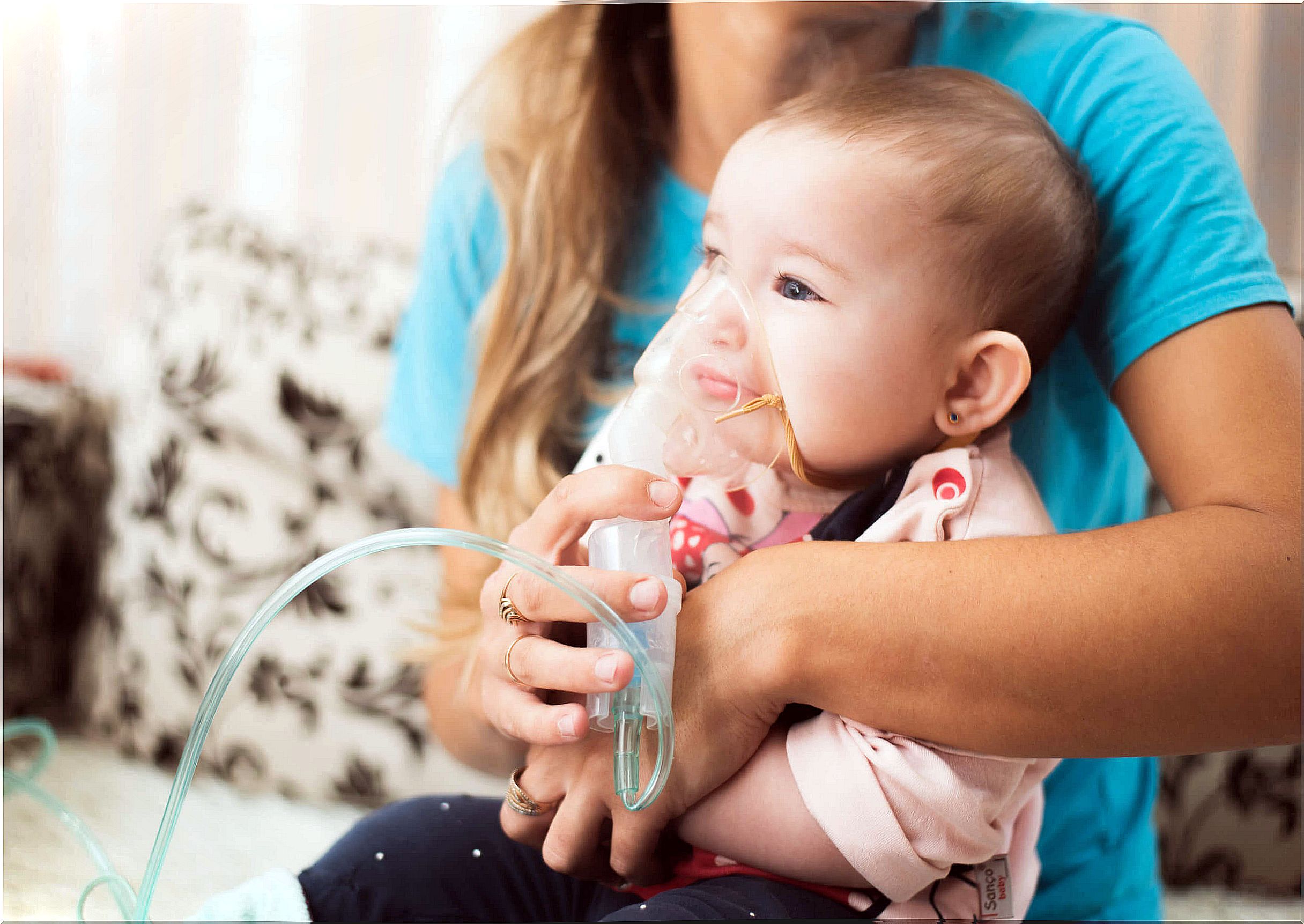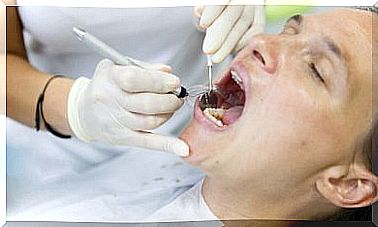Bronchiolitis: Causes, Symptoms And Treatment
Acute bronchiolitis (AB) is a very common disease in childhood. Its approximate annual incidence anywhere in the world is 10%; that is, one in 10 children under 2 years of age suffer from it every year. Furthermore, it is the most common cause of hospital admission for respiratory infections in this age group (1-5%).
There is no consensus regarding the definition of bronchiolitis, but it is generally associated with episodes of respiratory distress with wheezing preceded by a clinical picture of a catarrhal nature. If you want to know everything about this disease, we encourage you to continue reading.
Causes of bronchiolitis

As the United States National Library of Medicine indicates, bronchiolitis is a common lung infection in young children. From a clinical point of view, it is characterized by the accumulation of mucus in the smallest airways of the lungs (bronchioles). It is usually due to a viral invasion.
According to the journal Pediatría Integral, bronchiolitis occurs in epidemics during the winter and early spring. The population group most affected are young children between 3 and 6 months of age. Here are some of the most common causative agents.
1. Respiratory syncytial virus (RSV)
A negative single-stranded RNA virus of the paramyxovirus family ( Paramyxoviridae ) is responsible for 56% of patients with bronchiolitis requiring hospital admission. It is ubiquitous in most of the world, and it is estimated that almost all children in the world have already suffered from the disease by the age of 4.
2. Rhinovirus
It is a genus of viruses in the Picornaviridae family . They are the most common infectious agents in humans (causing colds) and there are more than 110 serological types capable of generating symptoms in our species. Although less common than with RSVs, rhinoviruses can also cause bronchiolitis in infants.
3. Parainfluenza virus type 3
The MSDmanuals portal shows us that parainfluenza viruses are classified into 4 types. Type 3 is the one that causes the most cases of bronchiolitis, but variants 1 and 2 can also generate it in an exceptional way. Infections caused by parainfluenza are indistinguishable from those caused by RSV, but they are usually less serious.
Risk factor’s
Bronchiolitis can affect everyone, but it is vastly more common in breastfeeding and immunocompromised children. As indicated by the KidsHealth portal, some of the most common risk factors are the following:
- Being a baby or small child: their noses and airways are much more fragile than those of other adults. Its bronchial tree is shorter and smaller in diameter so, in the face of inflammation, the chances of obstruction are much higher.
- Belong to the group of infants who have experienced premature births.
- In children who have a compromised immune system or concomitant pulmonary and cardiovascular diseases.
- Exposure to tobacco smoke, repeated stay in environments with a high density of children and exposure to certain toxic chemical compounds.
In general, being a young child is the most relevant risk factor. As we have said, approximately 70% of infants come into contact with respiratory syncytial virus in the first year of life. However, this does not mean that they will suffer from bronchiolitis: only 22% develop symptoms.
Symptoms of bronchiolitis
The United States National Library of Medicine shows us some of the most common symptoms of bronchiolitis in infants. However, not all children develop them. Among them, we can find the following:
- Breathing difficulty including wheezing and shortness of breath.
- Cough, fatigue and fever. These clinical signs are some of the precedents to bronchiolitis, typical of a catarrhal infection.
- The muscles around the ribs sag as the child tries to inhale. The baby’s nostrils flare as he breathes with the intention of picking up more air with each inhalation cycle.
- Tachypnea; that is, rapid breathing.
Usually, bronchiolitis manifests 24-48 hours after the previous clinical signs. The mean duration of symptoms is 12 days, although up to 18% of affected infants carry the clinical picture for 21 days, exceptionally reaching one month (9%).
Possible complications

As indicated by sources already cited, the loss of respiratory capacity by the newborn can be lethal. If your child has presented symptoms of bronchiolitis and one day you notice his skin with a bluish tone (cyanosis), it is essential that you go to a medical emergency center. Cyanosis indicates a very severe shortness of breath.
Pauses in breathing, dehydration, and low blood oxygen levels are also clinical signs that indicate considerable severity of bronchiolitis. These are only conceived (in the vast majority of cases) in premature babies or in those with a previous disease.
What treatment options are there?
According to the specialized portal Neumoped, there is no medication that facilitates the cure of bronchiolitis. As it is a viral disease, we can only hope that the infant’s immune system will be able to deal with viruses on its own. However, most cases are mild and do not require medical action.
It is necessary to emphasize that, on these occasions, going to the consumption of antibiotics is of absolutely no use. This could only worsen the clinical picture by encouraging the bacterial strains that live inside the infant to strengthen in the long term. In any case, in admitted children the approach changes drastically.
Hospital treatment
When an infant is admitted for bronchiolitis, the greatest concern is that he or she will regain a normal respiratory rhythm. For this, oxygen (30-40%) is applied in a nasal cannula or facial mask in order to maintain an oxygen saturation greater than 90%. Endotracheal intubation is necessary in the most severe cases.
On the other hand, it is also sought for the patient to regain a natural water balance. For this, oral serum intakes are administered and, in the most compromised cases, intravenously (IV).
Recommendations at home
The vast majority of cases are treated from home with patience and dedication. Although it is not possible to help the child to fight the disease, its symptoms can be reduced with a series of very simple actions. Among them are the following:
- Keep the infant hydrated: Make sure that the child gets an adequate amount of fluid in order to avoid dehydration as a result of the disease.
- Perform frequent nasal washes: There are over-the-counter liquids at the pharmacy that help decongest the upper respiratory tract in both infants and adults. This will make it easier for the patient to breathe.
- Keeping the child up, even when they go to sleep: this will promote adequate air movement, much better than if they were lying down.
- Use a humidifier: it is always a good idea to place a vaporizer in the sick infant’s room, especially at bedtime. This will soften the accumulated mucus and, therefore, the symptoms of coughing and nasal congestion will be alleviated.
A common illness that usually resolves on its own
As we have said in previous lines, bronchiolitis is an extremely common disease in infants and, therefore, there is no need to worry if a child suffers from it. The vast majority of cases resolve themselves, so you just have to be patient and follow some instructions at home, so that the child can be more comfortable.
In any case, if you notice any of the clinical signs mentioned in the “possible complications” section, it is essential that you go to an emergency center promptly. If the child is severely compromised his breathing capacity, his life is in danger in the short term.








